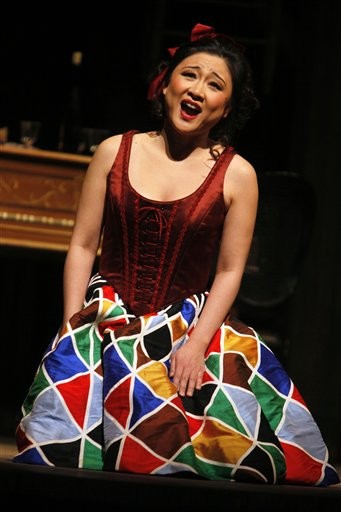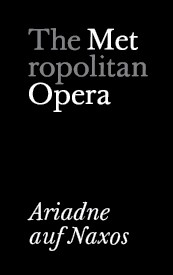Adriadne auf Naxos at the Metropolitan Opera
Nina Stemme Is a Glorious Adriadne
By: Susan Hall - Feb 16, 2010
Adriadne auf Naxosby Richard Strauss
libretto by Hugo Hofmannsthal
Metropolitan Opera
February 15, 2010
Conducted by Kirill Petrenko
The winter woes that came with the Metropolitan Opera's revival of "Ariadne auf Naxos" lifted when tenor Lance Ryan rejoined the cast. This "Ariadne" is a 1993 production, but feels as fresh as anything now on the boards. A complicated opera that librettist Hugo Hofmannsthal talked the composer Strauss into writing operates on many, perhaps too many levels. This mounting by the Met contends admirably with the multi-facets.
The first act prelude to an opera production is set in the home of the richest man in Vienna. The mansion's imposing stairway is raised stage right, an in-house theater to its left. On floor level, the composer of the opera within the opera writes and negotiates for a prominent presentation of his important, tragic piece.
This composition is deemed an audience killer. To make it more acceptable, a merger between opera seria, and fluff from commedia d'arte is proposed. At first the composer is horrified by the trashing of his work. When he is swept into the reality of present emotion by comedienne Zerbinetta, he caves. This is only half the story, but it will do to set up the scene.
We are introduced to Sarah Connolly as the composer. Lotte Lehmann sang the role at the premier of the revised version which is used today. The opera had opened to scathing reviews in Stuttgart and was re-tooled for Vienna.
Lehmann had been a star in Hamburg, everyone's "spoiled darling", but arrived in Vienna as an understudy for the composer role. One day, Marie Gutheil-Schoder, cast in the role and admired by Lehmann as a great singing actress, who Lehmann "worshipped with all her heart", had a cold, and Lehmann was called in for the rehearsal.
Lehmann sang. "I forgot the very important onlookers (including Strauss) and with my whole being plunged into the glorious experience of again creating a part...I was wholly transfigured into the Composer."
Later that afternoon Lehmann was asked to rehearse at the Opera House and then told she was being given the role for the premier. Panicked that she was replacing her heroine (if you believe that!) she refused the role, but was told by Strauss that this was not her decision. On she went to a stunning career. Such tales we don't hear about this "Ariadne" at the Met. Connolly has a lovely voice and was convincing in the trouser role.
Hofmannsthal was entranced with a stylized 18th century aura, and had been taken with a production of the Moliere-inspired "Le bourgeois gentilhomme" with incidental music and opera. Strauss instead wanted to return to tragedy after Rosenkavalier, but Hofmannsthal derailed the scenario of "The Stone Heart" based on a folk tale. He had complained that his libretto was swamped with music in Rosenkavalier and bamboozled Strauss into "Ariadne" with a small 37 piece orchestra, trying to keep words first and foremost.
The first act as staged here has some lovely arias by the composer, but it is largely spoken theater, which is what interested Hofmannsthal.
The second act is where the opera-within-the-opera is presented. The set designed by Michael Yeargen provides a deepening series of locations, created in part with light by Gil Wechsler. Three nymphs, in contrast to the Rhine Maidens swimming under water, are positioned high above the stage on a raised platforms wheeled around beneath them, and sing admirably under seemingly perilous conditions.
It is in the opera-within-the-opera that we hear the glorious music of Strauss, particularly in the role of Ariadne sung by the Swedish soprano, Nina Stemme. Her voice fills the hall comfortably, rising from her so naturally, and with such a rich texture. "Ariadne" is opera seria. She awaits Theseus who has abandoned her on a desert island and wishes only for death. After prodding by Zerbinetta, she accepts the god Bacchus when he at last arrives. By accepting him, she accepts life. It is these explanations by Hofmannsthal that finally sold Strauss on the story. Hofmannsthal is not here to clear up confusion about how choosing to go and live with the gods and opting out of human life is "life." It is enough that Strauss bought into the idea.
Zerbinetta's coquettish coloratura aria, in which Strauss refers to Donizetti and Bellini, is one of the most challenging in the literature. Kathleen Kim was charming in the role. She's a tiny woman who the commedia d'arte characters were able to lift and swing during the proceedings. The hoisting might have been foregone in favor of a soprano with more heft. Having just heard Diana Damrau sing the aria with the Met Orchestra under James Levine, it seemed unfortunate that Damrau has been re-deployed to Barber of Seville and La Fille du Regiment. Mine was an opinion of one as neighbors found Kim absolutely delightful.
The tenor Lance Ryan returned from illness to sing Bacchus. He is an imposing singer. His offstage voice, before he enters, was full of squillo -- that thrilling ring. On stage, his head voice notes were always sung with strength to which some brightness was added as he opened up.
Stemme was the star of the evening. With a totally satisfying set, lighting ,and costumes, this production is amusing and entertaining. The production features one of the most glorious sopranos of our day.





